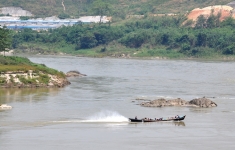Dam Building Slows in Southeast Asia: Construction Faces Opposition Over Social, Environmental and Geopolitical Factors
Originally published in The Wall Street Journal
Hydropower dams in parts of Southeast Asia are being canceled or suspended as governments face stronger opposition, forcing them to take greater responsibility for environmental and social impact or look to other sources of energy.
The resistance, in a region where vast hydropower potential remains untapped, occurs as energy demand is skyrocketing. With dams facing opposition over social, environmental and geopolitical factors, the days of indiscriminate building may be coming to an end, requiring countries to reconsider energy security and energy sharing in Southeast Asia.

In Vietnam, the government shelved plans for more than 420 small hydropower dams in October after a public outcry over safety. The backlash followed the deaths of dozens of people after operators felt no choice but to release water from reservoirs overwhelmed by heavy rains. Cambodia, too, is facing difficult questions about proposed new dams as alleged shoddy building resulted in dam collapses.
In Laos, opponents of a $3.5 billion dam on the Mekong River say they are upset about the potential impact on migrating fish stocks and how this might affect people downstream who depend on the river for their livelihoods.
Myanmar has halted construction of a large dam at Myitsone by Chinese developers.
"Governments, dam builders and the public at large are more aware of the serious social and environmental impacts of hydropower projects," said Peter Bosshard, policy director at activist group International Rivers, which campaigns against projects it doesn't feel are environmentally or socially sound.
But some governments aren't budging on hydropower, which they claim is a healthier, green alternative to dirty energy sources, such as coal.
Southeast Asia is growing increasingly hungry for energy, with demand expected to increase by more than 80% by 2035, according to the International Energy Agency. About $1.7 trillion of additional investment will be required to meet that. The region has a lot of catching up to do with its more developed neighbors; about 22% of Southeast Asia's population has no household access to electricity and clean cooking facilities, according to the IEA.
Hydropower accounted for some 10% of the region's energy supply in 2011, according to the energy agency. While that proportion is likely to increase to just 11% by 2035, energy experts say that the potential for development is huge, particularly on the Mekong River, a 5,000-kilometer (3,107-mile) waterway that runs through six countries, from China to Vietnam, and supplies an estimated 60 million people with water and food. Only 10% of the estimated hydroelectric potential in the Southeast Asian part of the river is developed, according to the Mekong River Commission, a multilateral organization founded in 1995 by countries sharing the river.
Laos is one such country. In line with its ambition to be the battery of Southeast Asia, its government gave the go-ahead last year for the development of the $3.5 billion dam at Xayaburi on the Mekong River, arguing it is environmentally sustainable. The decision was opposed by Vietnam and Cambodia and condemned by environmental groups for its defiance of an international agreement to suspend work until the dam's downstream impact could be fully assessed.
For the region's poorest countries, hydropower offers an opportunity for rapid economic development and foreign investment. In the case of Laos's Xayaburi, 95% of electricity the dam generates will go to Thailand.
"Laos is implementing the Thai electricity strategy, not the Laos electricity strategy," said Marc Goichot, a Mekong expert at the environmental group WWF.
Chong Chi Nai, director of energy for the Southeast Asia department at the Asian Development Bank, which has funded dam projects in the region, says Southeast Asia's hydropower potential still offers an attractive option to environmental groups.
"When developed in an environmentally and socially sustainable manner, [hydropower] will help to reduce the dependence on fossil fuels for power generation," Mr. Chong said.


